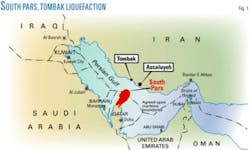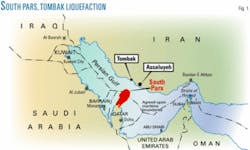Iran’s government actively supports building the country’s natural gas liquefaction capacity as a means of commercializing production from its South Pars Phase 11-13 developments.
This article examines the background for this effort and some of Iran’s competitive advantages before detailing the three liquefaction projects currently under way.
Background
Natural gas follows oil and coal in share of the global energy market, currently providing 23% of the world’s energy needs.1 Its share, however, has been growing.
Several factors have led to this growth, foremost among which have been:
- A sharp rise in proven natural gas reserves worldwide.
- The growing priority given by major oil importing countries to security and diversification of energy supplies.
- Growing concern for the environment.
Iran has the second largest proven natural gas reserves in the world. The country has published proven natural gas in-place of more than 27.57 trillion cu m, 18% of the world’s total natural gas reserves.1
Iran’s South Pars gas field, with 13.177 trillion cu m of natural gas and 19 million bbl of condensate, and its other large reservoirs are located primarily in shallow waters within a few kilometers of its coastline, making them easily accessible to relatively low cost development.
The advantageous location of these giant natural gas reserves allows for a variety of export alternatives:
- To the Pacific Rim as LNG.
- To Europe as LNG or via pipeline.
- To Pakistan and other neighboring countries via pipeline.
- To India and China as LNG or via pipeline.
- To other Far Eastern countries such as Japan and South Korea as LNG.
This article examines Iran’s LNG-related plans for developing these resources, which the country’s leadership has made a high priority in fueling the nation’s continued growth.
Competitive advantages
A number of factors contribute to Iran’s emergent strength as a global supplier of natural gas. These include:
- World-class, low cost gas resource base in the South Pars field.
- Significant condensate revenue stream to underpin LNG economics.
- Strategic geographic location.
- Strong government support for LNG exports.
- Access to a diverse technical and commercial workforce.
South Pars is a reliable gas resource with extremely competitive development costs. The high volume of condensates produced by the field provides a significant revenue stream. Based on experience gained from LNG projects elsewhere in the world, liquids revenues will play an essential role in underpinning overall project economics.
Iran is strategically located, with the potential to compete for markets in Europe, India, and Asia Pacific, a particular advantage given the increasingly competitive nature of the LNG market. Iran’s government is keen to pursue this advantage by supporting development of the country’s LNG liquefaction infrastructure.
In times of low domestic demand, gas currently delivered into Iran’s domestic gas infrastructure could instead act as backup supplies for the LNG plants if upstream supplies are interrupted. This could be a crucial point in early development of the LNG projects and represents a competitive advantage over the majority of competitors, most of which lack a similarly developed domestic market.
Projects
• NIOC LNG. NIOC LNG is 100% owned by National Iranian Oil Co., directed by National Iranian Gas Export Co. NIOC’s board of directors awarded frontend engineering design in 2001 to a consortium of JGC and Technip.
NIOC expects to produce 10 million tonnes/year of LNG by 2010, using a two-train plant fed by almost 1.94 bcfd of natural gas from South Pars Phase 12.
NIOC divided the project into three packages to facilitate efficient implementation and increase use of domestic resources:
- Package I: Processing and condensation units, utility, offsite equipment, and the top section of the quay.
- Package II: LPG and LNG storage tanks and accessories.
- Package III: Sulfur, LPG, LNG, and condensate loading quays.
The plant will be located on Tombak Island, 60 km from Assaluyeh and will target Europe and Asia. It will use two 5-million tonne/year trains.
The plant will use Linde liquefaction technology, gas-phase mercaptan removal, six gas turbine compressor drivers arranged in parallel, Claus process sulfur recovery, and an acid-gas removal system from BASF through Lurgi Oil-Gas-Chemie GmbH. It will use a hybrid seawater-air cooling medium and steam as its heating medium. Six gas turbine electrical drivers will supply the plant’s power.
Three 140,000-cu m containment tanks will hold LNG prior to loading.
• Pars LNG. NIOC (50%), Total SA (40%), and Petronas (10%) own this project, aimed at exporting 10 million tonnes/year of LNG to Europe, Asia, and the Far East. The plant will use two 5-million tonne/year trains.
The owners formed Pars LNG Ltd. in 2004 to handle frontend engineering design, market the second train’s production, call for the engineering, procurement, and construction tenders, and finance development of the project.
Pars LNG has completed FEED work and expects to begin production by 2009. This plant will also be located on Tombak Island.
In addition to LNG, Pars expects the plant to produce 680,000 tonnes/year of LPG, 250,000 tonnes/year of condensate, and 700 tonnes/day of sulfur, using 2 bcfd of natural gas from South Pars Phase 11.
The plant will use Axens liquefaction technology, liquid phase cryogenic process mercaptan removal, and electric motor compressor drivers arranged in series. It will use a hybrid seawater-air cooling medium and steam as its heating medium. Gas turbines with heat recovery will supply the plant’s power.
Three 155,000-cu m containment tanks will hold LNG prior to loading.
• Persian LNG. NIOC (50%), Shell (25%), and RepsolYPF SA (25%) own this project, aimed at exporting 16 million tonnes/year of LNG to Europe, Asia, and the Far East. The plant will use two 8-million tonne/year trains.
The owners signed a framework agreement in December 2004, following completion of feasibility studies. Frontend engineering design work is scheduled to begin June 2007, with production expected by early 2011. As with the other two facilities, this plant will be located on Tombak Island.
In addition to LNG, the Persian project expects to produce 1.5 million tonnes/year of LPG, 4.5 million bbl/year of condensate, and 200,000 tonnes/year of sulfur, using 2.8 bcfd of natural gas from South Pars Phase 13.
The plant will use Shell-DMR process liquefaction technology, Sulfinol-D molecular sieve mercaptan removal, and electric-motor compressor drivers. It will use an air cooling medium and have a combined-cycle power plant.
Three 160,000-cu m containment tanks will hold LNG prior to loading. A 65,000-cu m tank will hold butane and a 105,000-cu m tank propane.
Reference
- NIGC Annual Report, 2006.
The author
Hedayat Omidvar has been working since 1992 as a natural gas consumption expert in National Iranian Gas Co.’s corporate planning department. He currently heads NIGC’s strategic studies, research, and technology department. Omidvar holds an MS (2002) in industrial engineering. He is a member of the Institute of Industrial Engineers, the American Industrial Hygiene Association, and serves on the marketing committee of the International Gas Union.


